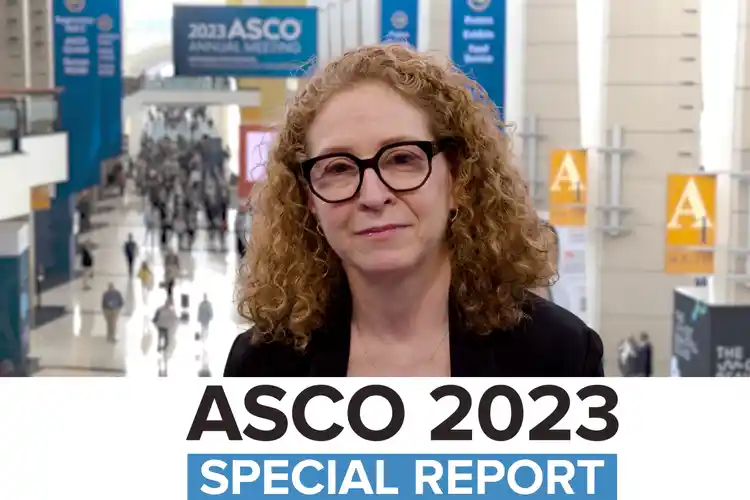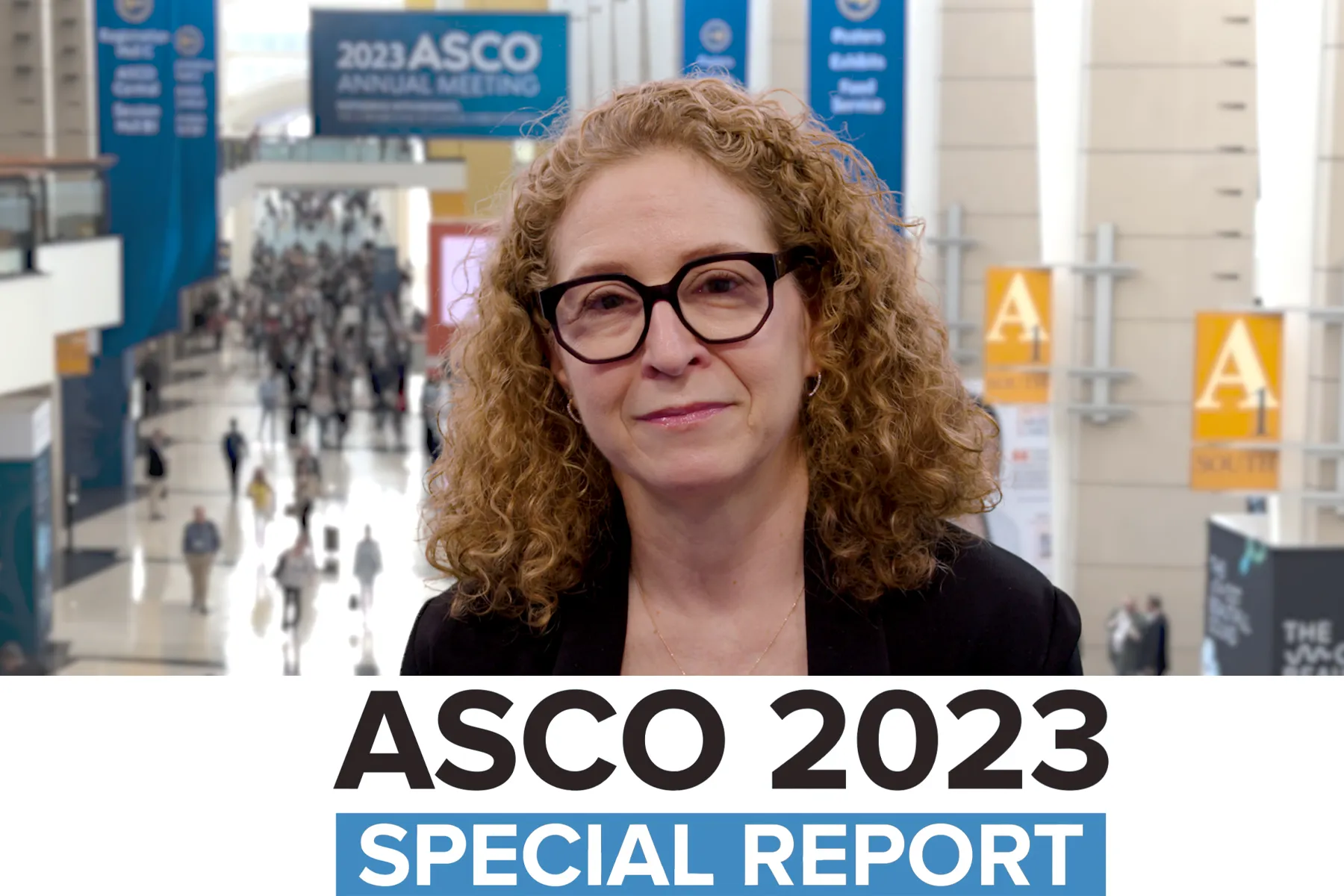
MARISA C. WEISS: Hello. I’m Dr. Marisa Weiss, Chief Medical Officer of breastcancer.org reporting here from ASCO 2023 with WebMD. There was an important study that looked at screening rates, and you can only imagine that at the beginning of 2020, with a pandemic, that screening rates plummeted because mammogram departments were closed and people were scared to go to hospitals, but that things started to get better at the end of 2020.
However, we have found that net-net here today, we’re in 2023, and this particular study reported out through 2022 where the screening rates are sagging. Like, we are down for breast cancer screening by, I don’t know, probably at least 10%. And I see it clinically as a doctor taking care of women with breast cancer, more people are showing up with late stages of disease. They missed their mammogram for a year or two before the pandemic, they haven’t gotten their mammogram during the pandemic, and only now they’re having cancer– like, big cancers present.
So if you’re listening to this, make sure that you and the people that you care about, the people you work with, get their mammogram on a regular basis, because mammography — early detection of breast cancer — can save your life.
MARISA C. WEISS: Hello. I’m Dr. Marisa Weiss, Chief Medical Officer of breastcancer.org, reporting to you from ASCO 2023 with WebMD. I’m reporting on a study that we, breastcancer.org, conducted through a survey. We had over 1,400 people participate, and we were looking at the impact of racial and ethnic background on your job — your employment. And not just your employment, but the employment of you and your caregivers.
And what we found was pretty extraordinary — that 92% of people had a change in their employment for — at the time of diagnosis, about 62% were working full-time. That dropped down to 40%. For women with metastatic breast cancer, that went from 56% down to 25% were working full time, just because the demands of care really messed up their work situation.
For people with non-metastatic breast cancer, full-time rate went from 63% down to 42% after treatment, and most people attributed that employment change to breast cancer and its demands. This was particularly true for women who were Hispanic, because they were more likely to have — be younger at diagnosis, have younger children at home, have later stages of disease, and have jobs that were inflexible so that they had to take unpaid leave. They were much more likely to have to take unpaid leave.
And for caregivers, for Hispanic women, about 58% of their caregivers had to drop down their employment from full-time down to part-time as an example. And it was 58% of Hispanic women compared to 41% for Black women, and 25% for White women, so there’s a big disparity there. So the bottom line is that breast cancer can really mess up your life, and your job is what puts food on the table and a roof over your head. And it doesn’t just affect you and your caregivers.
MARISA WEISS: Hello, I’m Dr. Marisa Weiss, Chief Medical Officer of breastcancer.org, reporting to you today from ASCO 2023 with WebMD. At breastcancer.org, together with Memorial Sloan Kettering Cancer Center, we conducted a survey to really find out how hard it is, the hoops you have to jump through in order to get short-term and long-term disability, as well as to fight back on insurance denials of your care. We had over 1,400 people participate in the survey. And about 60% were White, 27% were Hispanic, and about 8% were Black.
And most people had early stage disease, but 11% had metastatic disease. And what we found was that 32% of people applied for short-term disability, 26% applied for long-term disability, which was more common in people with metastatic breast cancer. And while 74% of people got approval for those disability payments, at least 25% said it was really hard. That just filling out those forms and sending them in and understanding the question and the language barriers, that it was a difficult process.
And, of course, it was worse for people with language barriers, like Hispanic women, that 50% more work, more difficulty. And for women with metastatic disease, more work, more difficulty to put those applications in. Also, about a third of people applied — submitted an appeal to their insurance company because the insurance company, let’s say, denied coverage of some of the charges.
And sometimes, people had to submit an appeal two to five times. And for people with metastatic disease, over five times. And so there’s a lot of work that goes into applying for disability, as well as FMLA, as well as appealing a denial from your insurance company.
So if you’re in that situation, don’t — first of all, you’re not alone. There are a lot of people who have experienced this. It’s a total drag, but you can get help.
MARISA WEISS: Hello, I’m Dr. Marisa Weiss, Chief Medical Officer of Breastcancer.org. Reporting from ASCO 2023 with WebMD. I just want to let you know about a study out of Columbia University in New York that looked at the prevalence, that’s the rate of chemotherapy-induced peripheral neuropathy, which means like numbness and tingling pain of your hands and your feet. It also might mean difficulty with motor functions like buttoning a shirt or opening a jar like peanut butter or whatever it is you open a jar for.
And what they found was that chemotherapy-induced peripheral neuropathy was more common in people who were receiving paclitaxel, also called Taxol chemotherapy when compared to docetaxel or Taxotere chemotherapy. We kind of already knew this, but it’s good to see yet another report that shows that that for the patients who had paclitaxel or Taxol chemotherapy, the rates of chemotherapy-induced peripheral neuropathy was kind of high in this particular study, 50%. Whereas, it was 40% or so for people with paclitaxel.
So that’s a significant difference. So if you’re diagnosed with early-stage breast cancer or more significant stages of breast cancer, and your doctor tells you that you need to have chemotherapy, you want to ask them what kind of chemotherapy. And let them know that you’re aware that Taxol chemotherapy is more likely to produce the side effect chemotherapy-induced peripheral neuropathy. And find out what can you do to lower the incidence of chemotherapy-induced peripheral neuropathy.
One thing is the cryo-mitts, like these are cold mitts that you put your hands into during the infusion and afterwards that seems to drop the incidence of CIPN — chemotherapy-induced peripheral neuropathy.
And in another study, which I’ll tell you about in a moment, I was a principal investigator looking at the role of CBD, cannabidiol, which seemed to lower the intensity of numbness and tingling related to chemotherapy-induced peripheral neuropathy for patients who have that symptom.
So there are important steps that you can take to lower the incidence and the impact of chemotherapy-induced peripheral neuropathy on your quality of life.
MARISA C. WEISS: Hello. I’m Dr. Marisa Weiss, Chief Medical Officer of breastcancer.org, here with you at ASCO 2023 with WebMD. I’m reporting on an important study looking at the role of CBD — cannabidiol — in the treatment of patients with chemotherapy-induced peripheral neuropathy, people who had either peripheral neuropathy from a taxane like Taxol or Taxotere, or from a platinum-based chemotherapy for their treatment.
And what we found was that when we looked at the people in the study — they were either randomized to receive 135 milligrams of CBD derived from hemp versus placebo, and they took the medicine for 3 months, and we watched them for another month. We found that the patients who received CBD instead of placebo had a lower incidence of numbness and tingling, but no change in the pain or their motor function when compared to the people on placebo.
And this is actually an important result, because CBD was well-tolerated. It reduced the symptoms of numbness and tingling, which are a common, difficult side effects from these commonly-used medicines. And that side effect actually stands in the way of a lot of people completing their chemotherapy, especially Black women who are dealing with breast cancer. They’re more likely to have chemotherapy-induced peripheral neuropathy and stop their treatment early, which may in part explain why they have worse outcomes with a higher risk of dying from breast cancer.
So we certainly need to find ways to help prevent chemotherapy-induced peripheral neuropathy. I also talked about the cold mitts to lower the incidence. But then, if you have this condition, what can you do to lower the intensity of it and the duration of that symptom? And it looks like CBD, cannabidiol– and the product we used was Ananda Hemp Ecofibre. They actually supported the study. I just wanted to disclose that to you.
One hundred thirty-five milligrams a day compared to placebo. It’s available online, over-the-counter. You do not need a medical marijuana card to get these CBD products from hemp. And it lowered the incidence of numbness and tingling, which is a common difficult side effect from chemotherapy, which helps to improve your quality of life.
https://img.wbmdstatic.com/vim/live/webmd/consumer_assets/site_images/article_thumbnails/video/covid19-images/ASCO_START_Weiss_1800x1200.jpg
2023-06-14 17:38:42





